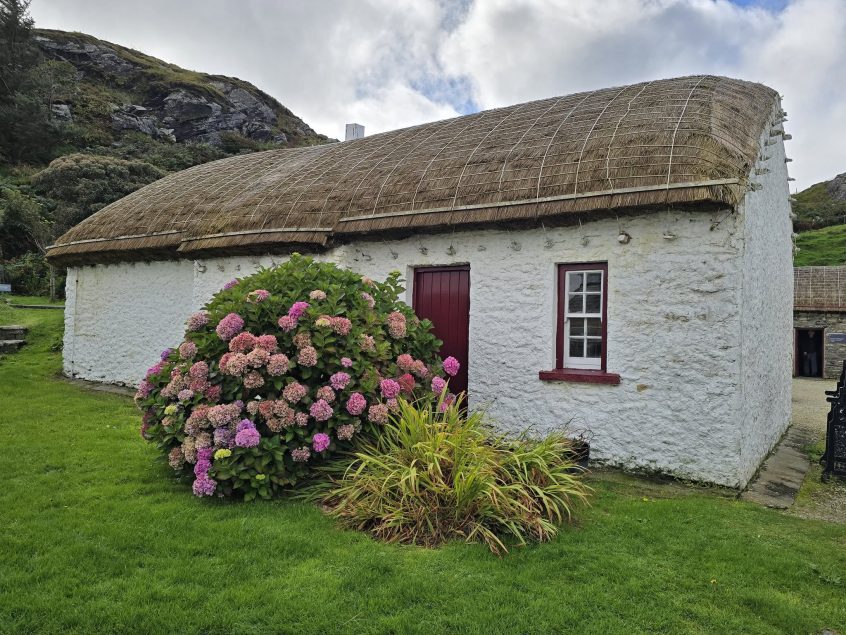Today was the unofficial start of the conference I am attending. Because the conference is for travel content creators, the sponsors (mainly tourist boards) want us to experience the local attractions so we can communicate with our audiences about them. For two days they offer us a variety of tours in the area. I could have chosen from bicycling through the countryside, visiting local distilleries, hiking, lighthouse tour, and many others. I chose to learn a little Irish language and tour a folk village.
What I hadn’t accounted for, nor had anyone else, was that it took two hours to drive to the remote, rural area in the north. In truth, I didn’t mind—the scenery kept my attention. In many ways it reminded me of New Zealand—lush green and more sheep than people.
Both New Zealand and Ireland are celebrated for their “green” landscapes, but the character of that greenness is quite different. In Donegal, the green is soft and uniform. Frequent rain creates lush grasslands that roll across hills and valleys like a carpet. When the land is cultivated it feels domesticated and pastoral. Even in the wild, uncultivated places we drove through, there was a sense of order, in part because there isn’t much diversity of vegetation.
When I visited New Zealand, the greenery seemed untamed, dramatic, and diverse. The range of their vegetation is vast: from dense forests to fern-filled rainforests and alpine grasslands. I was in constant amazement about the variety of ferns, some arching taller than a person while others looked like miniatures, and everything in between. I spent hours looking at the hundreds of different mosses.
What they share are a huge number of sheep. Today I got up close and personal with several of them and throughout the time we spent in the folk village we could hear them baa-ing in the nearby field.
We drove through intense rain, drizzle, and bright sun. The weather changed every few minutes. This must be the norm, as it has happened every day since I arrived.
Our first stop was a class to introduce us to the Irish language. We learned basic polite phrases like hello (dia duit, pronounced jee-a ditch) and please (leh do thoil, pronounced Leh do hall). The closest Irish name to mine is Caireann. Our teacher explained the history of the language, the oldest in Western Europe (it became standardized in the fifth century). We found out that tenses exist in Irish that we don’t have in English, like present habitual (for things you do regularly) and a plural for you (like you’all in the American south). It was fun and highly informative.
Then we walked to the Folk Center. The walk took us close to the neighborhood sheep.
At the folk center we got to see how people in this rural area lived throughout the centuries. Thatch roof homes from around the county were brought in and restored. There were a schoolhouse, pub and shop, several homes and a fisherman’s hut. In the hut we spoke with a retired fisherman. While he chatted with us he was knotting a net used for catching lobsters. He never missed a knot even while deep in conversation.
In another building we watched wool spinning, knitting, and the making of Celtic crosses from native rush (straw). Here too, everyone was very chatty and friendly. It is the Irish way. I was given a just-made Celtic cross as a souvenir.
Lunch was vegetable soup, brown bread with butter and an Irish coffee.
On our way back to Kilkenny we stopped briefly at a pub, the Rusted Mackerel, to hear traditional music. It was wonderful.
Then, another long drive back to Letterkenny. By the time I got back to the Airbnb, I was happy to call it a night.

